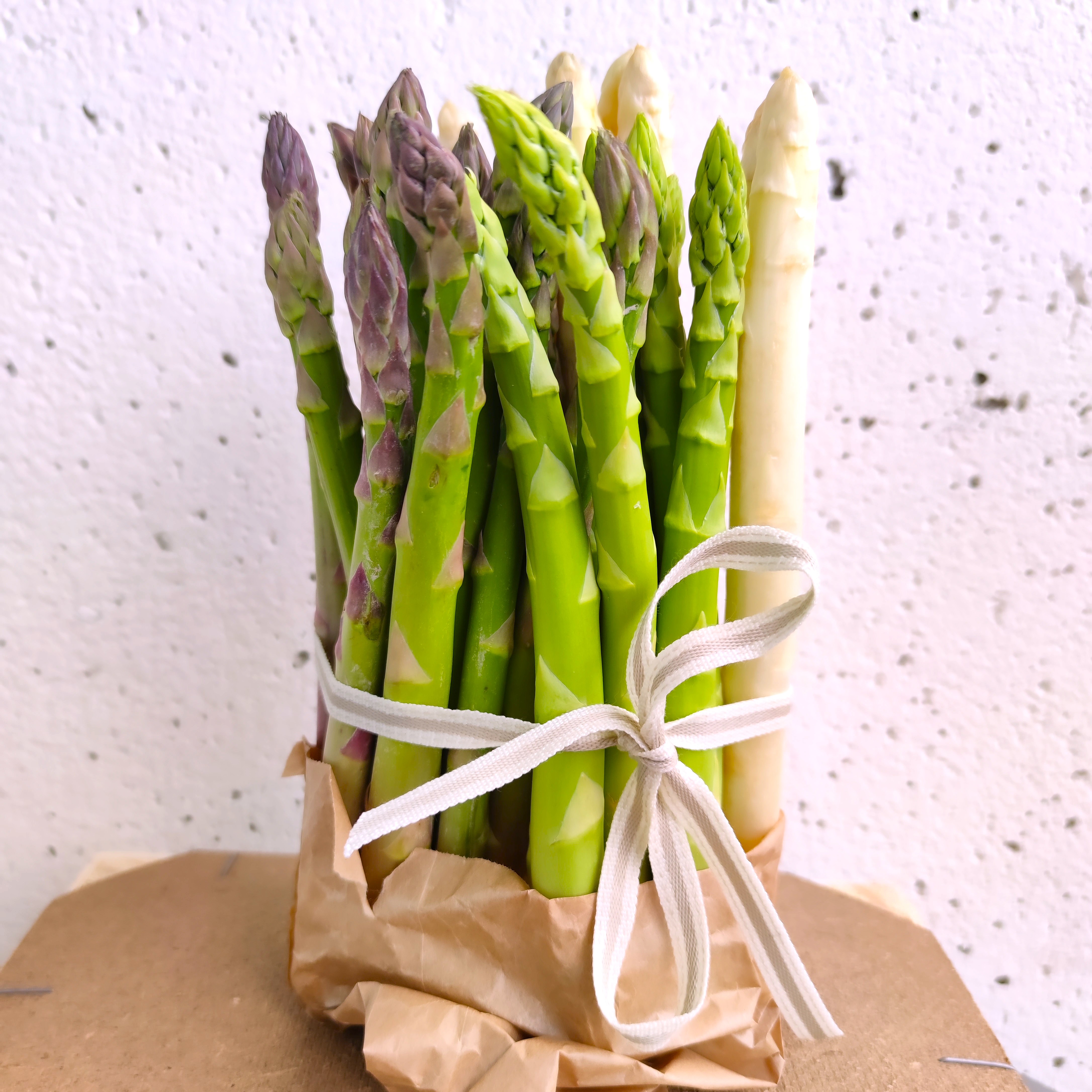It was in a small farmers’ market near Visby where I saw them for the first time—asparagus so pale they looked like they had never seen the sun. Thick, almost sculptural spears, white as ivory, and right beside them, a few with deep lavender crowns. I paused. For a moment, I was back in Liguria—Albenga to be precise—where violet asparagus grows proudly and uniquely. Those short, plump spears with their bold color and gentle sweetness have their own festival in spring. I never thought I’d feel something so close to it in Sweden.
Here, in the open air of Gotland’s coast, I inhaled a familiar crispness with a Nordic twist. This wasn't Albenga, but it carried the same spirit—a sense of season, of care, of waiting all winter for the earth to offer something tender again. And it got me thinking: how would these flavors speak in the form of lasagna?
Back in Italy, the first sight of asparagus at the market is a sign that the cold months are officially behind us. Families begin preparing lighter dishes, packed with seasonal vegetables, and in Liguria, Piedmont, or Veneto, that means dishes where asparagus becomes the star. One of my favorite things about cooking with this vegetable is how it lends itself to both elegance and simplicity. It’s versatile enough to stand proud in a creamy risotto or be delicately tucked between pasta sheets in a homemade lasagna.
The violet asparagus from Albenga has always been close to my heart. Its flavor is a little nuttier than the green kind, with a sweetness that only comes from having grown slowly in a mild Mediterranean climate. And yes—there's something poetic in how it needs to wait three whole years before you get a single edible spear. That’s how long it takes to mature from seed to harvest. A commitment. A quiet rhythm that teaches patience.
Funny enough, I had never thought about asparagus as a Scandinavian thing until I saw it flourishing in Gotland’s sandy soil. But it turns out Sweden has a long, if not widely known, tradition of cultivating it. The conditions in Gotland—plenty of light, the sea breeze, and the well-drained soil—make it ideal for growing premium asparagus. And when you taste it, you understand why the locals hold it in such high regard.
There’s something incredibly satisfying about mixing the best of both worlds. In our version of lasagna, we use Swedish spring asparagus, sourced from local farms when in season, and we layer it with a light ricotta cream, grated Parmigiano Reggiano, and a whisper of lemon zest to highlight the freshness. The result is a joyful, green-tinged tribute to the season—elegant but deeply comfort food.
This dish might be a little different from the classic meat-filled lasagna most people expect, but that’s kind of the point. It speaks to the beauty of home cooking, of using what’s around you, of celebrating both Swedish ingredients and Italian ingredients in one delicious, bubbling tray. And it’s completely vegetarian food—something we’ve grown to love even more with each passing spring.
And for those who like knowing what’s on their plate, asparagus brings more than just beauty and flavor. It’s naturally low in calories and rich in fiber, which makes it not only satisfying but also gentle on the stomach. It’s also packed with folate and antioxidants—those helpful little compounds that play a role in supporting overall wellness. But let’s not get too scientific here. All we’ll say is: it’s good for you, and it tastes amazing. What more do you need?
One of the nicest things about asparagus—whether green, white, or violet—is how it changes slightly depending on how you cook it. Roasted, it gets nutty and almost caramel-like. Steamed, it stays tender and clean. Grilled, it takes on a smoky punch. And in lasagna, it melts slightly into the layers, keeping its shape just enough to surprise you with every bite.
I sometimes imagine an Italian nonna standing in a Swedish kitchen, blinking at the sight of Gotland’s asparagus and wondering how such a thing came to grow so far north. And maybe she’d be skeptical at first—until she tasted it. That moment when cultures meet and melt, like cheeses in an oven, that’s where the magic happens. Italian food traditions are beautiful in their roots, but they’re also meant to travel, to adapt, to connect with local seasons and stories.
Just like Italians once brought their food culture to Swedish cities and added their own twist to Swedish habits, now Swedish ingredients are finding their way into Italian traditions. This kind of quiet culinary exchange happens over time, often without anyone really noticing—until one day, someone says, “Hey, you know what would taste amazing in this lasagna?” And a new favorite is born.
So what kind of lasagna can you make with asparagus and a Swedish twist? The answer might be simpler than you think. Take what’s fresh, respect the ingredient, and cook it with care. Add a creamy base, something tangy, a touch of heat if you like it, and never, ever skimp on good cheese. That’s the rule.
What’s your favorite asparagus recipe? Ever tried making a spring version of lasagna with asparagus? Can you imagine the rich aroma of freshly baked and warm, homemade lasagna filled with Parmigiano Reggiano and a rich mix of spring veggies with a super generous presence of asparagus?
Or just make it easy—come by our takeaway in Stockholm and try our lasagna with asparagus. Only during the season, of course. No shortcuts, no frozen fillers—just proper homemade food, prepared with the respect that locally sourced ingredients deserve.
Spring doesn’t last forever, but some flavors have a way of staying with you.

